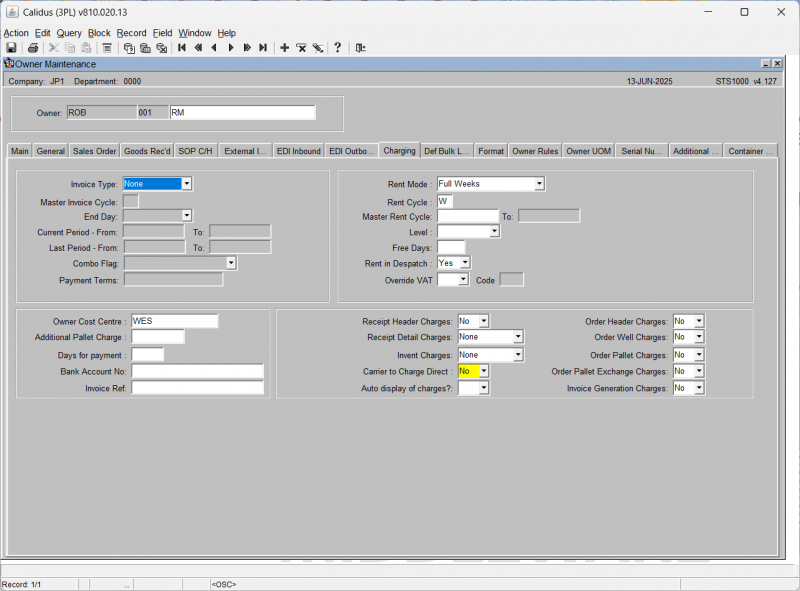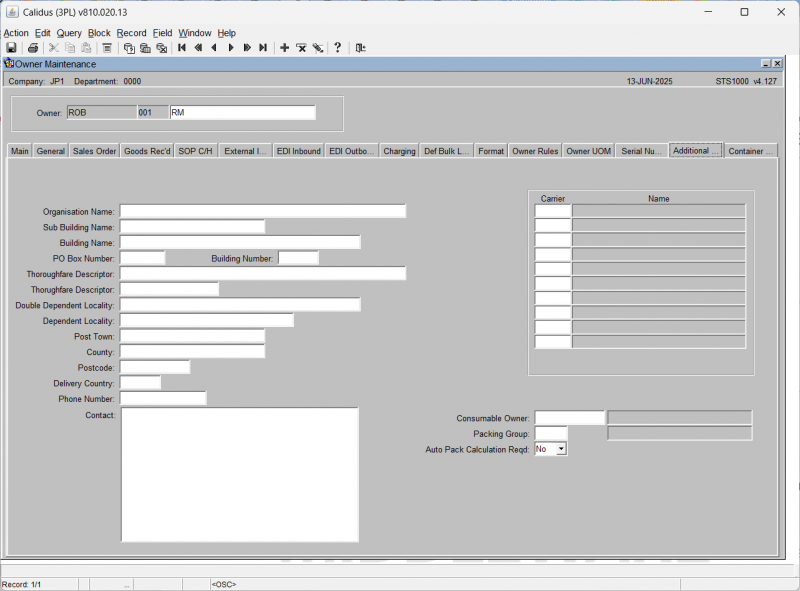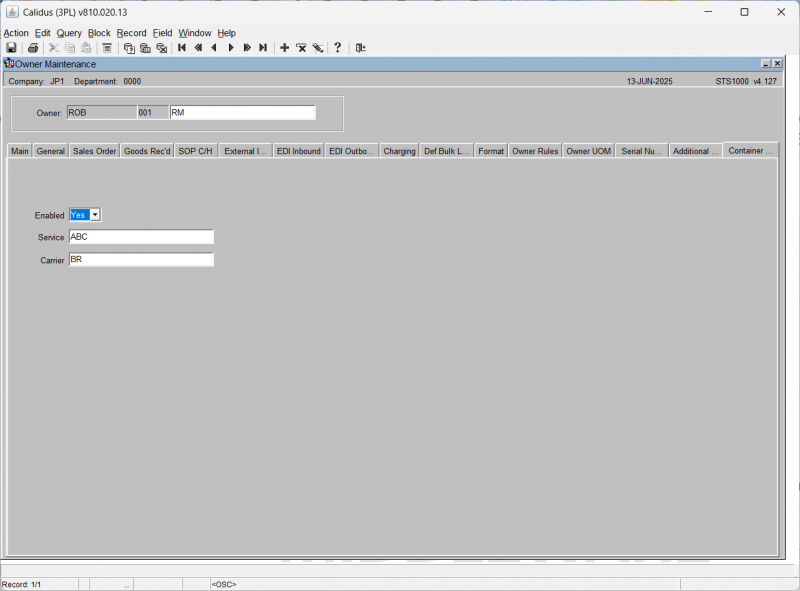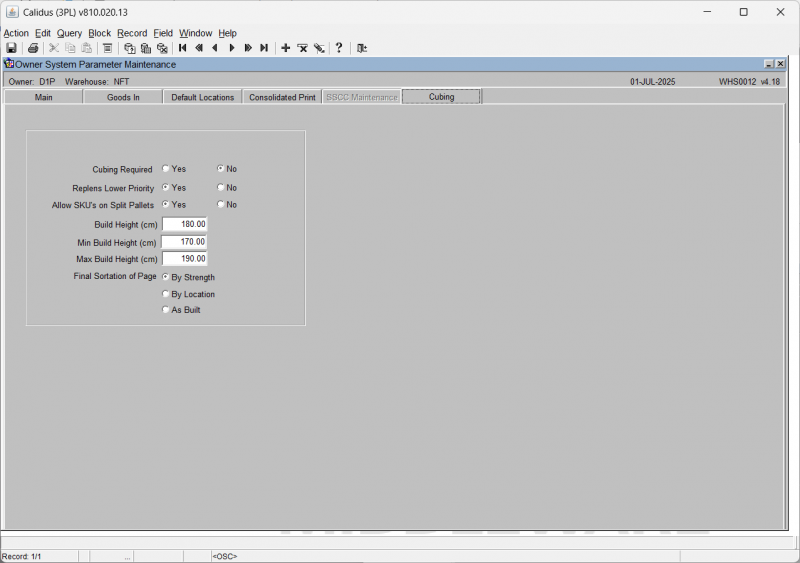UG 352167-4 C-WMS Owner Set-up Guide
![]()
Aptean
C-WMS Owner Set-up Guide
CALIDUS WMS
1st July 2025 - 2.01
Reference: FS UG 352167-4
Owner Set-up
Owner Maintenance
This document describes the required screens to be used in setting up the information concerned with the Owners of stock in the warehouse. Other guides describe the set up of company, user, warehouse, stock etc.
This is a generic guide based on the version of the CALIDUS WMS system at the time of writing.
It can also be used by clients to specify their specific data values to aid initial system set up as well as for future reference.
Note that fields marked '**' are mandatory and are needed to ensure correct set up of the system.
Owner Maintenance - Main Tab
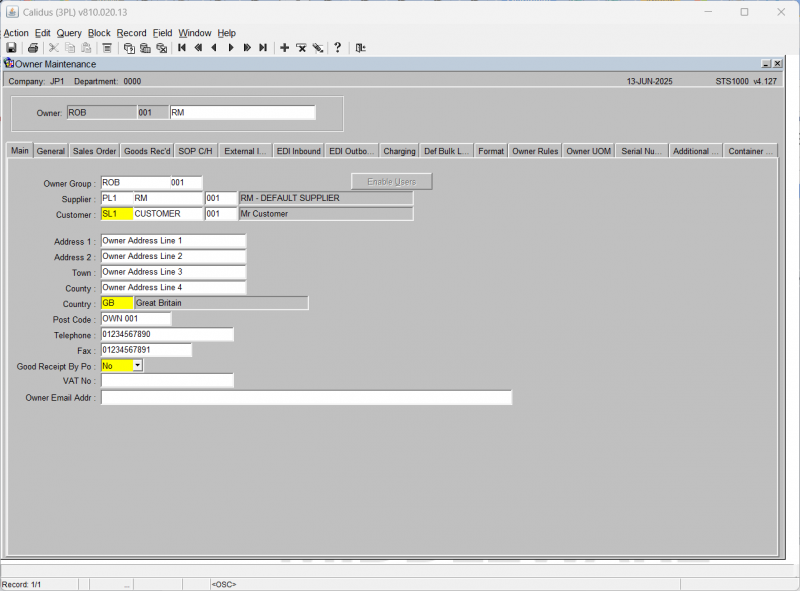
| Field Name | Description | Options | Generic Value |
|---|---|---|---|
| Owner ** | Owner code - note, in order to setup an owner from scratch or to make any amendments or changes to the parameters within this screen - you must have registry setting 'OwnerSuperUser' set to '1' | 10 character free text field - note, for RF and other processing, the owner code must only be 3 characters - LOV available in query mode | Defined by the client |
| SubCode ** (not labelled) | Sub code of the owner - this allows the user to have the same owner code with multiple entries, however, the standard is always '001' | 3 character free text field | 001 |
| Description (not labelled) ** | The name of the owner | 30 character free text field | Defined by the client |
| Owner Group ** | Used for EDI reporting purposes, the ability to group multiple owners under one owner. This then becomes the master and the 'owner group' - (not migrated) | Must exist in owner maintenance - will default to current owner code - LOV available | Defined by the client |
| Supplier - 1st field - ledger code ** | Ledger code associated with the supplier | Must have been created in ledger codes maintenance and assigned to the user id - always PL1 | PL1 |
| Supplier - 2nd field - supplier code | Default supplier for the owner - this can be used at goods receipt to automatically default in this supplier code at pre advice | Must have been created in partners maintenance - LOV available | Defined by the client |
| Supplier - 3rd filed - supplier sub code | The sub code for the default supplier for the owner | 001 or left blank | Defined by the client |
| Customer - 1st field - ledger code ** | Ledger code associated with the customer | Must have been created in ledger codes maintenance and assigned to the user id - always SL1 | SL1 |
| Customer - 2nd field - customer code | Default customer for the owner | Must have been created in partners maintenance or customer wizard - LOV available | Defined by the client |
| Customer - 3rd filed - customer sub code | The sub code for the default customer for the owner | 001 or left blank | Defined by the client |
| Address 1 | The first line of the address for the owner | 30 character free text field or left blank | Defined by the client |
| Address 2 | The second line of the address for the owner | 30 character free text field or left blank | Defined by the client |
| Town | The town in which the owners address is situated | 30 character free text field or left blank | Defined by the client |
| County | The county in which the owners address is situated | 30 character free text field or left blank | Defined by the client |
| Country ** | The country in which the owners address is situated | Must have been created in country codes maintenance - LOV available | Defined by the client |
| Post Code | The post code for the owners | 10 character free text field or left blank | Defined by the client |
| Tel | The tel no for the owners address | 20 character free text field or left blank | Defined by the client |
| Fax | The fax no for the owners address | 14 character free text field or left blank | Defined by the client |
| Goods Receipt by PO | Defines whether receipts by purchase orders are required (not migrated) | Y or N | N |
| VAT No | The VAT number | Lookup | |
| Owner Email Addr | Owner's email address |
Owner Maintenance - General Tab
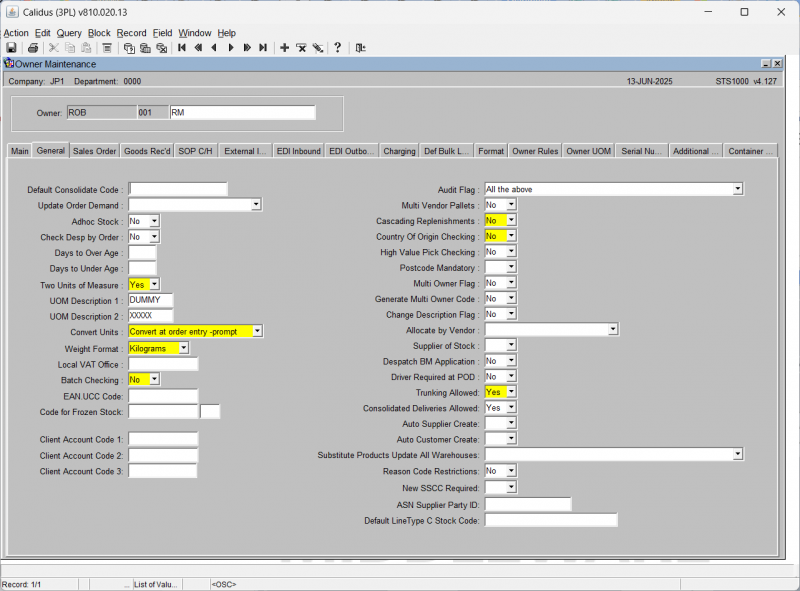
| Field Name | Description | Options | Generic Value |
|---|---|---|---|
| Default Consolidate Code | Allows you to enter a code which will validate against the owner's receipts and orders to be consolidated from collection no. or advice note and order header details - client specific (not migrated) | None | Blank |
| Update Order Demand | Allows you to update the order demand records (used for reporting purposes) - not migrated | 1 - Update with ordered quantity 2 - Update with pick confirmed quantity or left blank |
Blank |
| Adhoc Stock | If set to 'Y', allows the user to be automatically taken into the stock set up screen if they enter a product that does not exist (not migrated) | Y or N or left blank | Defined by the client |
| Check Desp by Order | Enables the prevention of despatching orders on a route load individually | Y, N or left blank | Defined by the client |
| Days to Over Age | As per the same stock fields, this states how many days the product is in the warehouse before it is over age (see stock maintenance guide for details) - this value will apply to all products for this owner (not migrated) | 0 - 999 or left blank | Blank |
| Days to Under Age | As per the same stock fields, this states how many days the product is in the warehouse before it is under age (see stock maintenance guide for details) - this value will apply to all products for this owner (not migrated) | 0 - 999 or left blank | Blank |
| Two Units of Measure ** | Dictates whether the owner will be using cases and units, rather than just cases | Y or N | Defined by the client |
| UOM Description 1 | Description of the highest unit of measure to be used if two units of measure flag is set to Y (not migrated) | Must have been set up in unit of measure maintenance or left blank - LOV available | Blank |
| UOM Description 2 | Description of the lowest unit of measure to be used if two units of measure flag is set to Y (not migrated) | Must have been set up in unit of measure maintenance or left blank - LOV available | Blank |
| Convert Units ** | Specifies whether, if using two units of measure, you wish the system to explode the number of units into cases | N - Do not convert units to cases Y - Convert at order entry - Prompt E - Convert at order entry - do not prompt |
Defined by the client |
| Weight Format ** | The default weight for the owner | Must exist on the ml_captions table for weight_format | Defined by the client |
| Local Vat Office | Specifies the reference number for the location VAT office | 10 character free text field or left blank | Blank |
| Batch Checking ** | Do you require the system to do an additional check on batch quantities. I.e. for stock adjustments, the user will be prompted for a batch amount - the adjustment will not be completed until the amount adjusted = the batch amount (not migrated) | Y or N | N |
| Audit Flag ** | Determines what auditing records the system will keep. This will note changes to the various records for future reference (partially migrated) | 0 None 1 Stock and Owner 2 Bonded Stock and Bonded Owner 3 Stock Records Only 4 Owner Records Only 5 Bonded Owner and Owner 6 Bonded Stock and Stock 7 All the above - will default to 'Stock and Owner' |
1 |
| EAN.UCC Code | Used for SSCC number/label production - this client specific company prefix number is used within the SSCC autogenerated number | 10 character free text field or left blank | Blank |
| Code for Frozen Stock | A field for a 'virtual owner' code to be used to allow changes of state of stock by 'change of ownership' (i.e. frozen to chilled etc) without using a product level flag | 10 character free text field plus sub code field or left blank | Blank |
| Multi Vendor Pallets | Specifies whether the owner will have more than one supplier - this will flag for a supplier code to be entered at all positive additions to stock quantities (not migrated) | Y or N | N |
| Client Account Code 1 | Client specific additional reference code for the owner | 10 character free text field or left blank | Blank |
| Client Account Code 2 | Client specific additional reference code for the owner | 10 character free text field or left blank | Blank |
| Client Account Code 3 | Client specific additional reference code for the owner | 10 character free text field or left blank | Blank |
| Cascading Replenishments ** | Does the owner use cascading replenishment. This is used if the owner has multiple uoms and wishes to cascade the replenishment to each one i.e. unit to box, box to case, case to pallet and back down again (not migrated) | Y or N | N |
| Country of Origin Checking ** | Determines whether the system will force the user to validate the country of origin during processing (not migrated) | Y or N | N |
| High Value Pick Checking ** | Are high value check digits required prior to pick confirmation? (not migrated) | Y, N or left blank | Blank |
| Postcode Mandatory | Is the postcode to be mandatory for customers address? (not migrated) | Y, N or left blank | Blank |
| Multi Owner Flag | Is this owner a multi owner or not. If set to Y, can be used to enable multi owner ordering under one owner i.e. if one product exists under 2 owners, an order placed under this owner would allow allocation from either (not migrated) | Y, N or left blank | Blank |
| Generate Multi Owner Code | If the owner is a multi owner, should the system generate a multi owner reference? (not migrated) | Y, N or left blank | Blank |
| Change Description Flag | Determines whether, if copying a product to a new product, whether the product description can be changed | Y, N or left blank | Blank |
| Allocate by Vendor | If allocate by vendor = 1 or 2, the system will prompt you for a supplier on order entry. If there is insufficient stock for this stock/supplier combination, (even if there is stock for a different supplier) the allocation will fail (not migrated) | 0 - Do not allocate by supplier 1 - Allocate-update for types 1-8 2 - Allocate-update for all types or left blank |
Blank |
| Supplier of Stock | If this flag is set to 'Y', the system will prompt for a supplier at goods receipt (not migrated) | Y, N or left blank | Blank |
| Despatch BM Application | Determines whether a BM application number is required at despatch - client specific (not migrated) | Y, N or left blank | Blank |
| Driver Required at POD | Specifies whether, at POD confirmation a drivers name is required (not migrated) | Y or N - will default to No | No |
| Trunking Allowed ** | Used in conjunction with the waybill screen, specifies whether orders can be Mantled (Mantling relates to a delivery to an intermediate distribution centre before the individual shipments are separated according to their end delivery points) - the waybill screen will check this flag to see if this process is required | Y or N | Defined by the client |
| Consolidated Deliveries Allowed ** | Used in conjunction with the waybill screen, specifies whether orders can be Samtaxered (Samtaxering relates to the grouping of multiple orders for the same delivery point and the subsequent production of one Waybill) - the waybill screen will check this flag to see if this process is required | Y or N | Defined by the client |
| Auto Supplier Create | Option select Yes or No | Defined by the client | |
| Auto Customer Create | Option select Yes or No | Defined by the client | |
| Substitute Products Update All Warehouses | No - Changes only apply to current warehouse
Prompt - ask user before applying changes to all warehouses. Yes - Automatically apply changes to all warehouses. |
Defined by the client | |
| Reason Code Restrictions | Yes or No | Defined by the client | |
| New SSCC Required | Yes or No | Defined by the client | |
| ASN Supplier Party ID | Defined by the client | ||
| Default Line Type C Stock Code | Defined by the client |
Owner Maintenance - Sales Order Tab
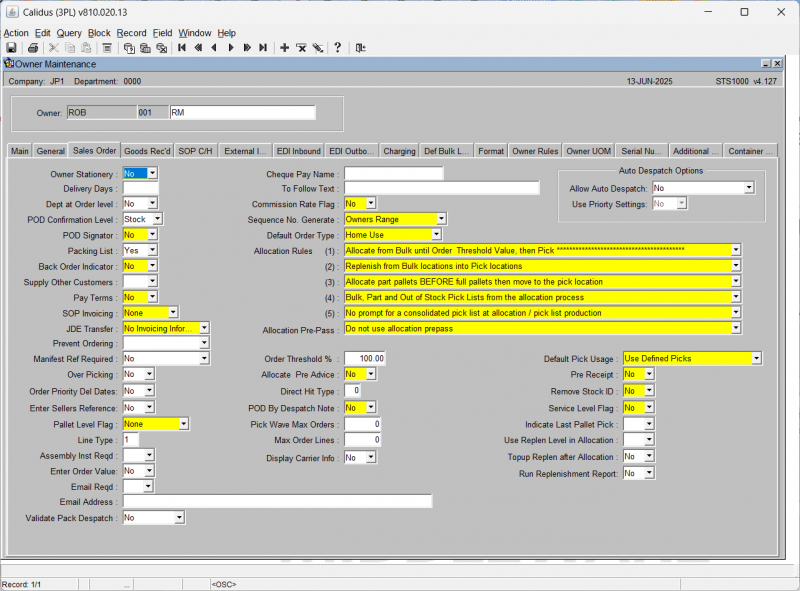
| Field Name | Description | Options | Generic Value |
|---|---|---|---|
| Owner Stationery | Is documentation produced from the WMS to be pre-printed on the client's own stationery? (not migrated) | Y or N - will default to No | N |
| Delivery Days | Indicates how many days are required to deliver stock for this owner (not migrated) | 0 - 999 or left blank | Blank |
| Dept. At Order Level | Determines whether a department code should be prompted for at order entry (not migrated) | Y, N or left blank | Blank |
| POD Confirmation Level | Determines whether POD will be actioned at stock or pallet level (not migrated) | S - POD Confirm at Product level (no regard for batch or pallets) P - POD Confirm at Batch/Pallet level - or left blank |
Blank |
| POD Signator ** | Determines whether a signature is required at entry of POD before confirmation is allowed | Y or N | Defined by the client |
| Packing List | Determines whether a packing list is required, and if so, at what point. Note, this is based on the 'old' packing functionality. If set to 'Y' and then use the new packing screens, the system will prevent you from despatching orders. | N No P Pick Y Yes |
N |
| Back Order Indicator ** | Used in conjunction with product and product class flags to determine whether back ordering is required (not migrated) | Y or N | N |
| Supply Other Customers | Indicates whether this owner will supply other owners' customers (not migrated) | Y, N or left blank | Blank |
| Pay Terms ** | Used in the old invoicing functionality - if flag set to 'Y', would override standard payment terms (not migrated) | Y, N or left blank | Blank |
| SOP Invoicing ** | Relates to old invoicing functionality - determines when invoicing is to be produced (not migrated) | N - None I - Immediate W - Weekly |
None |
| JDE Transfer ** | Relates to old invoicing functionality - whether the invoices are to be interfaced to JDE (not migrated) | C Client Invoicing N No Invoicing Information S SOP Invoicing Y Submit all invoices to JDE |
N |
| Prevent Ordering | Used in conjunction with a similar flag at customer level, will determine whether sales orders can be generated or not | Y - Prevent ordering for all customers C - Prevent ordering if the customer flag is set to 'Y' N - Do not prevent ordering - or left blank |
Blank |
| Manifest Ref Required | Used in population of the PCK tables for packing messages. If set to 'Y' will prompt for a manifest reference at order entry. This will then be written to the PCK tables (Kewill) | Y, N or left blank | Blank |
| Over Picking | States whether the owner allows over picking at pick confirmation | Y, N or left blank | Blank |
| Order Priority Del Dates | Yes or No | ||
| Enter Sellers Reference | Yes or No | ||
| Pallet Level Flag ** | Determines whether pallet levelling is required, and if so, how (not migrated) | C By No. of Cases N None P Pallet Fill Factor |
N |
| Line Type ** | Specifies the default line type. This will dictate how the system allocates stock and in what priority | 1 - Standard 2 - Non-Stock 3 - Rotation 4 - Pallet 5 - Cust Rotation 6 - Cust Pallet R - Rot - Nocommit M - Medical |
1 |
| Assembly Inst Reqd | Yes or No | ||
| Enter Order Value | Yes or No | ||
| Email Reqd | Yes or No | ||
| Email Address | Email address if email is required. | ||
| Validate Pack Despatch | Carrier Required
Yes or No |
||
| Cheque Pay Name | Used in old invoicing functionality - the name to appear on the cheque (not migrated) | 20 character free text field or left blank | Blank |
| To Follow Text | Used in old invoicing functionality - 'to follow' text to appear on invoicing documentation - (not migrated) | 40 character free text field or left blank | Blank |
| Commission Rate Flag ** | Used in old invoicing functionality - determines whether the commission rate should be overridden (not migrated) | Y or N | N |
| Sequence No. Generate ** | Determines how the order number is generated when entering an order at order entry and/or edi (all migrated apart from no.4) | 1 General Range 2 Owners Range 3 Mandatory 4 Prefix with Order Class |
1 |
| Default Order Type ** | Specifies the default order type for this owner | C Community (EU) E Export H Home Use O No default processing |
H |
| Allocation Rules (1) ** | Dictates in what sequence the system will allocate the stock | 0 Bulk Until OT Then Pick 1 Pick Locations first 2 Bulk Locations first 3 ONLY from Pick Locations 4 ONLY from Bulk Locations 5 Partial Multi-Deep First 6 Sequence Against Stock 7 As 6 Till OT then Rule 3 Reverse |
Defined by Client |
| Allocation Rules (2) ** | Dictates the sequence for replenishment | 0 Replenish Bulk -> Pick 1 Replenish Replen -> Pick 2 Replenish Bulk -> Rep -> Pick 3 Do NOT Replen in Allocation |
3 |
| Allocation Rules (3) ** | Dictates the sequence for allocating part pallets vs full (bulk) pallets | 0 Part In Sequence 1 Part Before Full Pallets 2 Part After Full Pallets 3 Part in Sequence- Move to Pick 4 Part Before Full - Move to Pick 5 Part After Full - Move to Pick 6 Part Before Full - Rp Pt In Seq 7 Part After Full - Rp Pt in Seq 8 Pt Bf Ful - Rp Pt in Sq Mv Pick 9 Pt Af Ful - Rp Pt in Sq Mv Pick |
0 |
| Allocation Rules (4) ** | Dictates when and how the pick lists are produced (currently only 0 is applicable) | 0 Blk Prt and OOS PL from PL 1 Blk and Prt PL (Sep) from PL 2 Prt and OOS PL from PL 3 Blk and Prt (Cmb) from PL 4 Blk and Prt (Cmb). OOS from PL |
0 |
| Allocation Rules (5) ** | Dictates whether consolidated pick list is required and whether the system is required to prompt for it (not migrated) | 0 No prompt for Con PL at ALL/PCK 1 Do Prompt for Con PL at ALL/PCK |
0 |
| Allocation Pre-Pass ** | Determines whether the system should reset the order back to committed if there is insufficient stock in the warehouse, dependant on what level you wish it to restrict. | 0 Accept Shortages 1 Do Not Short Alloc. Order line 2 Do Not Short Alloc. Product Type 3 Do Not Short Alloc. Order 4 Do Not Short Alloc. Range C As N -unalloc set to committed N Do Not Use Allocation Prepass Y Use Allocation Prepass |
N |
| Order Threshold | Works in conjunction with allocation rule 1. The Break Point as a % of a Standard Pallet when Allocation will switch from Bulk to Pick | 0 - 100 or left blank | Defined by the client |
| Default Pick Usage ** | Will determine whether allocation has to allocate from pick locations first. Note, if this is set to 0 or 1, allocation will fail if no pick locations are set against the products | 0 Use Defined Picks
1 Must Exist Before Allocation |
2 |
| Alloc Pre-Advice ** | Specifies whether stock is allowed to be allocated if it is at the pre advice stage (not migrated) | Y or N | N |
| Pre Receipt ** | Specifies whether stock is allowed to be allocated if it is at receipt confirmed stage (not migrated) | Y or N | N |
| Direct Hit Type ** | Direct Hit type works in conjunction with the allocation rules. It uses the actual ordered quantity to specify which pallet to allocate from. The system will look for a pallet with the exact or nearest quantity available to that ordered. Dependant on which hit type used, determines which sequence of locations it searches in to allocate. (not migrated) | 0 - Do not use Direct Hits 1 - Hit in Sequence specified against the stock code 2 - Hit in Sequence with preference to pick 3 - Hit in Sequence with preference to bulk 4 - Hit in stock code sequence then oldest part pallet greater than remainder. 5 - Hit in sequence with preference to pick then oldest part pallet greater than remainder. 6 - Hit in sequence with preference to bulk then oldest part pallet greater than remainder |
0 |
| Remove Stock Id ** | Determines whether all system ids i.e. pallet id, rotation, sell by dates etc are removed on transfer to a pick location (not migrated) | Y or N | N |
| POD by Despatch Note ** | Indicates whether POD is to be displayed in despatch note sequence (not migrated) | Y or N | N |
| Service Level Flag ** | Indicates whether a service level is mandatory at order entry (not migrated) | Y or N | N |
| Pick Wave Max Orders | Integer | ||
| Indicate Last Pallet Pick | Yes or No | ||
| Max Order Lines | Integer | ||
| Use Replen Level in Allocation | Yes or No | ||
| Display Carrier Info | Yes or No | ||
| Topup Replen After Allocation | Yes or No | ||
| Run Replenishment Report | Yes or No |
Owner Maintenance - Goods Received Tab
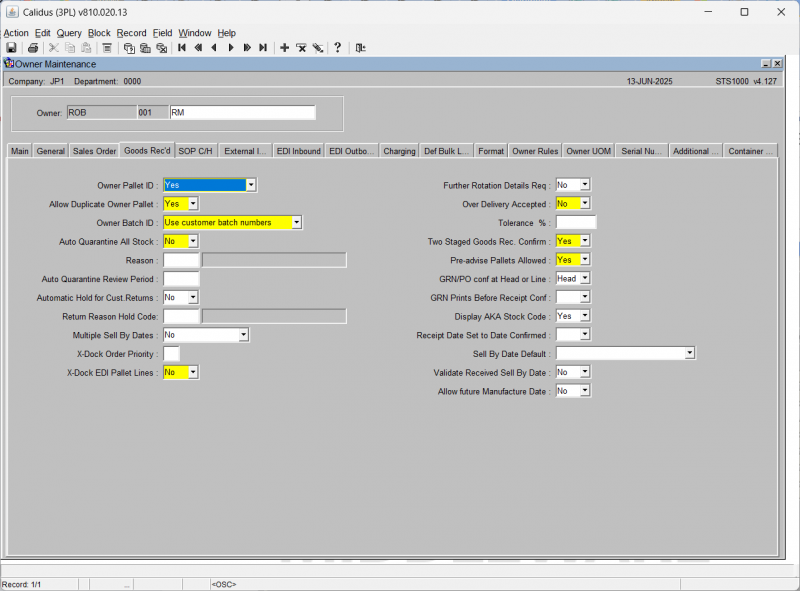
| Field Name | Description | Options | Generic Value |
|---|---|---|---|
| Owner Pallet Id ** | Specifies whether a customer pallet id is required | Y or N | Defined by the client |
| Allow Duplicate Owner Pallet Id ** | If customer pallet id's are required, are duplicates allowed? | Y or N | Defined by the client |
| Owner Batch Id ** | Specifies whether a customer rotation is required | N - Don't use cust batch numbers R - As Y - returns are restricted Y - Use customer batch numbers |
Defined by the client |
| Auto Quarantine All Stock ** | Rather than on product level, allows you to auto hold all products for this owner at receipt | Y or N | Defined by the client |
| Reason | Reason code for the auto quarantine if auto quarantine is set to 'Y' | Must exist on reason codes maintenance or left blank if no auto quarantine - LOV available | Defined by the client |
| Auto Quarantine Review Period | Sets the number of days the stock will be held under quarantine (not migrated) | 0 - 999 or left blank | Blank |
| Automatic Hold for Cust. Returns | Are goods received as a customer return to be automatically put on hold? - will generate a system reason code of '89' | Y or N | Defined by the client |
| Multiple Sell by Dates | Are pallets with the same rotation number allowed to have multiple sell by dates? (not migrated) | N No S No but amendable Y Yes |
N |
| X-Dock Order Priority | If an order priority code is entered here, only orders with that priority code can be cross docked | Must exist in order priority maintenance or left blank - LOV available | Defined by the client |
| X-Dock EDI Pallet Lines ** | Are the extra cross docked pallet details to be sent in the outbound receipt message (not migrated) | Y or N | N |
| Further Rotation Details Req | Are additional rotation details to be entered at receipt? | Y, N or left blank | Defined by the client |
| Over Delivery Accepted ** | Used with purchase ordering, determines whether this owner is allowed to receive more stock than advised on the P.O. | Y or N | Defined by the client |
| Tolerance % | If over delivery is set to 'Y' - a percentage of how much over the advised quantity you are allowed to receive | 0 - 100 or left blank | Defined by the client |
| Two Staged Goods Rec. Confirm ** | Determines whether an additional stage of goods receipt is required (not migrated) | Y or N | N |
| Pre-Advise Pallets Allowed ** | Determines if, at goods receipt, you wish to enter pallet level information | Y or N | Defined by the client |
| GRN/PO Conf at Header or Line | Determines whether receipt confirmation will occur at header or line level (not migrated) | H - Head L - Line - will default to header |
H |
| GRN Prints before Receipt Conf | Yes or No | ||
| Display AKA Stock Code | Yes or No | ||
| Receipt Date set to Date Confirmed | Yes or No | ||
| Sell By Date Default | Receipt Date + Intake Life
Manufacture Date + Intake Life System Date + Intake Life Rec Date + Intake Life + Alloc Man Date + Intake Life + Alloc Sys Date + Intake Life + Alloc |
||
| Validate Received Sell By Date | Yes or No | ||
| Allow Future Manufacture Date | Yes or No |
Owner Maintenance - SOP Charging Tab

| Field Name | Description | Options | Generic Value |
|---|---|---|---|
| SOP Invoicing Required | Determines whether SOP invoicing for this owner is enabled | Y, N or left blank | Defined by the client |
| Allow Change To: Price ** | Is the stock price at order entry, order invoice maintenance or pre-invoice allowed to be changed | Y, N or left blank - will default to No | Defined by the client |
| Allow Change To: Price Band ** | Is the Price band at order invoice maintenance or pre-invoice allowed to be changed | Y, N or left blank | Defined by the client |
| Allow Change To: Invoice Amount ** | Is the Invoice Amount at invoice maintenance or pre-invoice allowed to be changed | Y, N or left blank | Defined by the client |
| SOP Invoice : Minimum Number | Determines the lowest number in the range for the SOP invoice number. Invoice numbers will be generated from this value, incremented by 1 | 0 - 99999999 - will default to 0 | Defined by the client |
| SOP Invoice : Maximum Number | Determines the highest number in the range for the SOP invoice number. Invoice numbers will be generated upto this value | 0 - 99999999 - will default to 1 | Defined by the client |
| SOP Invoice : Last Number | Determines last number produced for the SOP invoice number. | 0 - 99999999 - will default to 0 | Defined by the client |
| Credit Note: Minimum Number | Determines the lowest number in the range for the Credit Note number. Invoice numbers will be generated from this value, incremented by 1 | 0 - 99999999 - will default to 0 | Defined by the client |
| Credit Note: Maximum Number | Determines the highest number in the range for the Credit Note number. Invoice numbers will be generated upto this value | 0 - 99999999 - will default to 1 | Defined by the client |
| Credit Note: Last Number | Determines last number produced for the Credit Note number. | 0 - 99999999 - will default to 0 | Defined by the client |
| Number Format | Allows the user to set the invoice number format to be either a sequential running number, or more client specific, the first 7digits of the invoice last number, the last number from the current year and a check digit based on modulo-10 | '0' - Sequential Invoice Number '1' - 7/Year/Mod10 or left blank |
Defined by the client |
| SOP Invoice | A predefined 3 character format to determine an owner specific invoice format | 3 character free text field - the format used must be a valid system source format or left blank | Blank |
| Credit Note Format | A predefined 3 character format to determine an owner specific credit note format | 3 character free text field - the format used must be a valid system source format or left blank | Blank |
| Despatch Docs | Determines what documentation is required - whether a delivery note and/or waybill is to be produced | B - Both Dnote and Waybill req'd D - Dnote only required W - Waybill only required |
Blank |
| Min, Despatch Document No. | Determines the lowest number in the range for the Despatch Note Number number. Despatch Note numbers will be generated from this value, incremented by 1 | 0 - 9999999999 - will default to 0 | Defined by the client |
| Max. Despatch Document No. | Determines the highest number in the range for the Despatch Note number. Despatch Note umbers will be generated up to this value | 0 - 9999999999 - will default to 1 | Defined by the client |
| Last Despatch Document No. | Determines last number produced for the Despatch Note number. | 0 - 9999999999 - will default to 0 | Defined by the client |
Owner Maintenance - External Interface Tab

| Field Name | Description | Options | Generic Value |
|---|---|---|---|
| External SOAP API Interfaces | |||
| Metapack Required | Is this interface required? | Y, N | N |
| NetDespatch Required | Is this interface required? | Y, N | N |
| Intelligent Shipper Required | Is this interface required? | Y, N | N |
| Click and Drop Required | Is this interface required? | Y, N | N |
| Pro Shipping Required | Is this interface required? | Y, N | N |
| Inbound Transport Interface Options | |||
| Loading Details/Email | Is this required? If so, the email address. | Unchecked | |
| Tracking Details/Email | Is this required? If so, the email address. | Unchecked | |
| Despatch Confirmation/Email | Is this required? If so, the email address. | Unchecked | |
| Outbound Transport Interfaces | |||
| Transport Interface Required | The type of TMS interface required. | No, Yes, TMS Interface | No |
| Record Pallet Count | Whether to record the pallet count | No, Yes | No |
| Record No. of Lifts | Whether to record the number of lifts | No, Yes | No |
| Ordered | Whether to interface at this status. | Unchecked | |
| Allocated | Whether to interface at this status. | Unchecked | |
| Pick List Printed | Whether to interface at this status. | Unchecked | |
| Pick Confirmed | Whether to interface at this status. | Unchecked | |
| Pack Confirmed | Whether to interface at this status. | Unchecked | |
| Despatch Confirmed | Whether to interface at this status. | Unchecked | |
| Other Interfaces | |||
| Account Code | |||
| Ext. Account Code | |||
| Invoice Format | |||
| Exclude from Interface | No, Yes | No | |
| Generate Tariffs | No, Yes | No | |
Owner Maintenance - EDI Inbound Tab
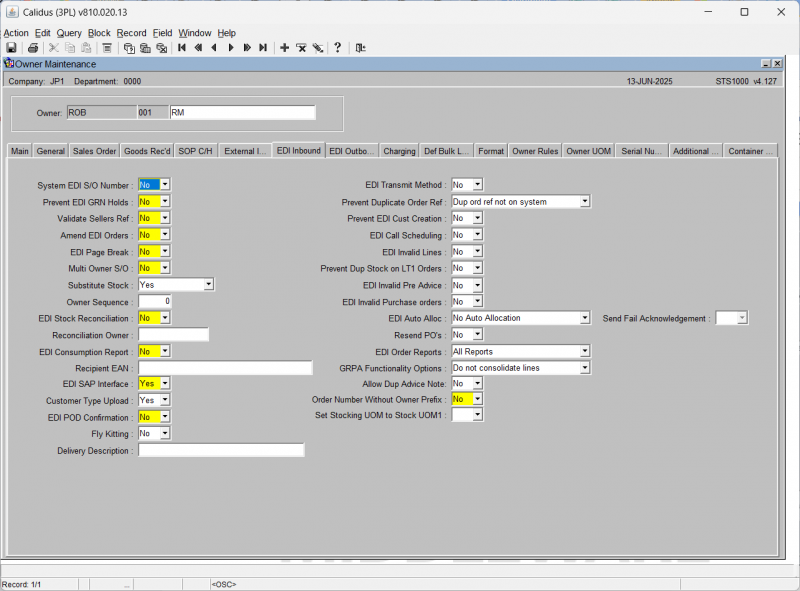
| Field Name | Description | Options | Generic Value |
|---|---|---|---|
| System EDI S/O Number ** | Determines whether, when using edi sales order uploads, you wish the system to auto generate the order number (not migrated) | Y or N - will default to No | Y |
| Prevent EDI GRN Holds ** | Determines whether you wish to prevent awaiting putaway holds from being mapped in edi (not migrated) | Y or N - will default to No | N |
| Validate Sellers Ref ** | Y or N - will default to No | N | |
| Amend EDI Orders ** | Is the user allowed to amend orders that have been created via edi? (not migrated) | Y or N - will default to No | Y |
| EDI Page Break ** | Do you wish a page break to be inserted at every order number in the edi message? (not migrated) | Y or N - will default to No | N |
| Multi Owner S/O | Y or N | N | |
| Substitute Stock | Used with the multi owner s/o flag. Specifies whether substitute stock codes are to be used. On upload the system will explode the orders out into muliple owner orders using substitute stock codes (not migrated) | Y or N | N |
| Owner Sequence | Used in conjunction with the multi owner s/o flag. Specifies what priority sequence the owners will have (not migrated) | 001 - 999 - will default to zero | 0 |
| EDI Stock Reconciliation ** | Determines whether this owner is to be included in the stock reconciliation edi report (not migrated) | Y or N - will default to No | N |
| Reconciliation Owner | The owner code to be displayed on the reconciliation report (not migrated) | 3 character free text field or left blank | Blank |
| EDI Consumption Report ** | Determines whether this owner is to be included in the edi consumption report (not migrated) | Y or N - will default to No | N |
| Recipient EAN | The European Article Number of the recipient of the edi messages | 35 character free text field or left blank | Blank |
| EDI SAP Interface ** | Used to enable SAP details to be entered at goods receipt. If set to 'Y' an additional button will appear at goods receipt to allow sap details | Y or N - will default to No | Defined by the client |
| Customer Type Upload | Yes or No | No | |
| EDI POD Confirmation ** | Yes or No | No | |
| Fly Kitting | Yes or No | No | |
| Delivery Description | |||
| EDI Transmit Method | Dictates whether EDI is to be used (not migrated) | Y or N - will default to No | N |
| Prevent Duplicate Order Ref | Determines, if using sales order upload, whether duplicate order references are allowed (not migrated) | A - Dup ord ref not on system N - Duplicate order ref allowed Y - Dup ord ref not on customer - default is N |
N |
| Prevent EDI Cust Creation | Specifies whether you wish the system to prevent customer codes from being prevented on sales order upload | Y or N - will default to No | N |
| EDI Call Scheduling | Client specific flag to enable telesales edi schedules (not migrated) | Y or N - will default to No | N |
| EDI Invalid Lines | Determines whether the system will allow orders with invalid detail lines (not migrated) | Y, N or left blank | Blank |
| Prevent Dup Stock on LT1 orders | Determines whether the system should prevent duplicate stock codes from being uploaded on a line type 1 order (not migrated) | Y or N - will default to No | N |
| EDI Invalid Pre Advice | Determines whether the system should allow invalid detail lines on inbound pre advice (not migrated) | Y or N - will default to No | N |
| EDI Invalid Purchase Orders | Determines whether the system should allow invalid detail lines on inbound purchase orders (not migrated) | Y or N - will default to No | N |
| EDI Out Alloc | Should the system only allow edi orders to be interfaced on the outbound allocation message (not migrated) | Y or N - will default to No | N |
| Resend PO's | Determines whether the system will allow previously uploaded purchase orders to be overwritten with new quantities from a new upload (not migrated) | Y or N - will default to No | N |
| EDI Order Reports | Specifies what type of report is to be produced on upload of an edi order (not migrated) | 0 - No Reports 1 - All Reports 2 - Over Committed Only 3 - Order Detail Summary 4 - Over Committed and Detail 5 - Over Committed and summary 6 - Order Detail Summary 7 - Order Summary Only |
0 |
| GRPA Functionality Options | Should pallet detail lines be consolidated or expanded on upload of the pre advice (not migrated) | N - Do not consolidate lines R - Don't consolidate expand palls S - Consolidate and expand pallets Y - Consolidate Lines |
N |
| Allow Dup Advice Note | Determines whether duplicate advice note numbers should be allowed on upload of pre advice | Y, N or left blank | Defined by the client |
| Order Number Without Owner Prefix ** | Should the system generated order number be allowed to not be prefixed with the owner code | Y or N - will default to No | N |
| Set Stocking UOM to Stock UOM1 | Y, N | N | |
| Send Fail Acknowledgement | Unchecked |
Owner Maintenance - EDI Outbound Tab
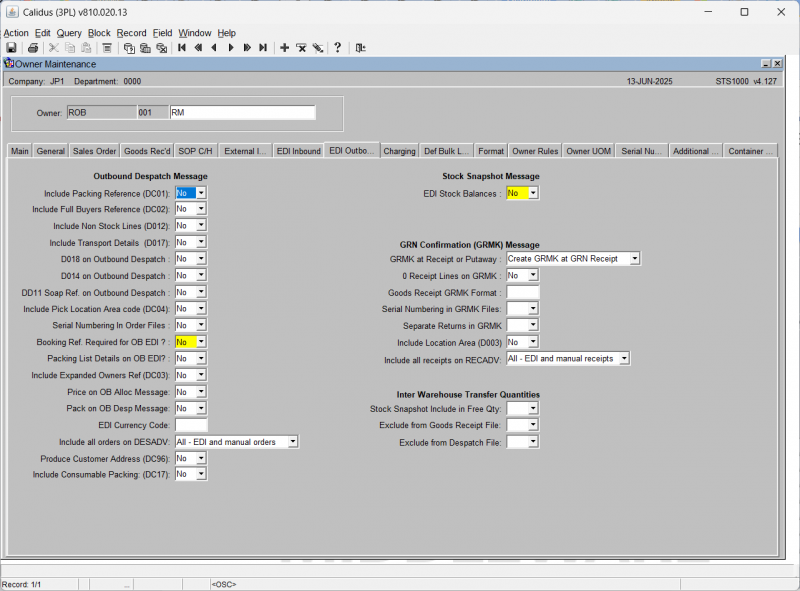
| Field Name | Description | Options | Generic Value |
|---|---|---|---|
| Stock Snapshot Message | |||
| EDI Stock Balances ** | Should the owner's stock balances be transmitted via edi (not migrated) | Y or N - will default to No | N |
| GRN Confirmation (GRMK) Message | |||
| GRMK at Receipt or Putaway? | Determines whether the outbound receipt confirmation message is sent after receipt confirmation or putaway confirmation P - Create GRMK at GRN Putaway R - Create GRMK at GRN Receipt - default is R |
Defined by the client | N |
| 0 Rec Lines on GRMK | Are zero received quantities to be sent in the outbound receipt confirmation message (not migrated) | Y or N - will default to No | N |
| Goods Receipt GRMK Format | Specifies which EDI receipt confirmation message is to be sent. (note, only one has been created so far) | HDM or left blank | Blank |
| Serial Numbering in GRMK Files | Y or N - will default to No | N | |
| Separate Returns in GRMK | Y or N - will default to No | N | |
| Include Location Area (D003) | Y or N - will default to No | N | |
| Include All Receipts in RECADV | Option Select
All - EDI and manual receipts EDI receipts only |
||
| Outbound Despatch Message | |||
| Include Packing Reference (DC01) | Y or N - will default to No | N | |
| Include Full Buyers Reference (DC02) | Y or N - will default to No | N | |
| Include Non Stock Lines (D012) | Y or N - will default to No | N | |
| Include Transport Details (D017) | Y or N - will default to No | N | |
| D018 on Outbound Despatch | Y or N - will default to No | N | |
| D014 on Outbound Despatch | Y or N - will default to No | N | |
| DD11 SOAP Ref on Outbound Despatch | Y or N - will default to No | N | |
| Include Pick Location Area Code (DC04) | Y or N - will default to No | N | |
| Serial Numbering in Order Files | Y or N - will default to No | N | |
| Booking Ref Required for OB EDI? ** | Should the booking screen be populated before the outbound Pick/Despatch message is sent (not migrated) | Y or N - will default to No | N |
| Packing List Details on OB EDI? | Are the packing list details to be sent on the OB Pick/Despatch Message? (Note, automatically sent on the SCH despatch flow with the SCH packing functionality) - (generic - not migrated) | Y or N - will default to No | N |
| Include Expanded Owners Ref (DC03) | Y or N - will default to No | N | |
| Price on OB Alloc Message | Y or N - will default to No | N | |
| Price on OB Desp Message | Y or N - will default to No | N | |
| EDI Currency Code | Y or N - will default to No | N | |
| Include All Orders on DESADV | Y or N - will default to No | N | |
| Produce Customer Address (DC96) | Y or N - will default to No | N | |
| Include Consumable Packing (DC17) | Y or N - will default to No | N | |
| Inter Warehouse Transfer Quantities | |||
| Stock Snapshot Include in Free Quantity | Y or N - will default to No | N | |
| Exclude from Goods Receipt File | Y or N - will default to No | N | |
| Exclude from Despatch File | Y or N - will default to No | N | |
Owner Maintenance - Charging Tab
This is split into 4 distinct sections:
Invoice Details – for Standard Invoice processing
| Field Name | Description | Options | Generic Value |
|---|---|---|---|
| Invoice Type | Flag to identify if Invoicing is applicable to this owner | NORMAL or
NONE |
|
| Master Invoice Cycle | Unique single character identifier for this owners cycle | Must be valid code from table INVOICE_CYCLE which will define it as Daily, Weekly, Half Monthly etc… | |
| End Day | If appropriate – defines that actual day that a period will end on | User defined | |
| Current Period From/To | The dates of the current Invoice Period for the Owner as defined by the running of the Invoice Production Process | Display only | |
| Last Period From/To | The dates of the last Invoice Period for the Owner as defined by the running of the Invoice Production Process | Display only | |
| Combo Flag | Identify whether Invoice and Credits should be produced as individual documents or combined onto one document | Drop down – COMBINED INDIVIDUAL | |
| Payment Terms | Free text for owner specific payment terms to be printed on Invoices | User input |
Rent Details – applicable to Rent Charge processing only
| Field Name | Description | Options | Generic Value |
|---|---|---|---|
| Rent Mode | Fixed definition of the type of Rent applicable for the owner | None / Advance / Average / Fixed Advance / Maximum | |
| Rent Cycle | Daily / Weekly / Monthly / Half-Monthly etc (as described above). Note that although the same table is used to define the CYCLE, the Rent and Invoice Cycle are separate processes. | As for Invoice cycle above | |
| Master Rent Cycle/To | Start and End date for the current Rent Cycle for the Owner | User sets up start date and system defines the end date based on the Rent Cycle and the regular (daily) update of rent processing. | |
| Level | The standard charge level for rent | Stock / Pallet / Rotation | |
| Free Days | Numeric value to represent the number of days that Stock can remain in the warehouse Free of Charge for rent | User input | |
| Rent in Despatch | Note this and WHOLE/PART, which is set by the MODE, determines if charges are for full periods, and whether or not Credits are to be generated when stock despatched (and the level of the credit). Also utilises the FREE DAYS to determine the generation of credits for rent already charged. | Yes / No flag | |
| Override VAT | Whether to override the VAT code | ||
| Code | The VAT code to use when overriding. |
Additional Information
| Field Name | Description | Options | Generic Value |
|---|---|---|---|
| Owner Cost Centre | An owner cost centre can be entered if required | Free Text | |
| Associated Pallet Charge | Legacy | N/A | |
| Days for payment | The number of days allowed for payment – between Invoice Date and Due Date printed on the invoice | N/A | |
| Back Account No | Legacy | N/A | |
| Invoice Ref | Free text reference for printing on the invoice | Free Text |
Charge Level Details – for control of individual ‘Charge Processing’
‘Auto charges’ (Charge codes with type of ‘Auto’) will be generated automatically within the individual processes if the appropriate flag is set to Yes. All are Yes / No flags (unless otherwise stated). These flags simply allow the user to ‘switch on/off’ charge generation for specific processing as required.
| Field Name | Description | Options | Generic Value |
|---|---|---|---|
| Receipt Header Charges | Receipt Header level | ||
| Receipt Details Charges | Receipt detail level | ||
| Invent Charges | Inventory Movements (inc. Freeze/Chill process) | ||
| Carrier to Charge Direct ** | Carrier charges (not UPM) – not used any more | ||
| Auto Display of Charges | Owner level check for display of auto generated charge codes (pre confirmation within individual processes) | ||
| Order Header Charges | Sales Order handling - Order header level | ||
| Order Well Charges | Sales Orders - Product type level | ||
| Order Pallet Charges | Sales Orders - Despatch pallet level | ||
| Order Pallet Exchange Charges | Special Pallet exchange code processing.
This checks if a specific charge is to be raised against the Stock Owner for the use of Pallets, due to the fact that neither the Stock Owner or their Customer has an account code for the Pallet Exchange system. |
||
| Invoice Generation Charges | Invoice generation process
Do we raise a charge each type we produice an Invoice for this owner? |
Owner Maintenance - Default Bulk Locations Tab
Used in conjunction with the putaway algorithm of stock. These locations can be used as anchor points at owner level. All products for this owner would then start their putaway locations from these anchor points.
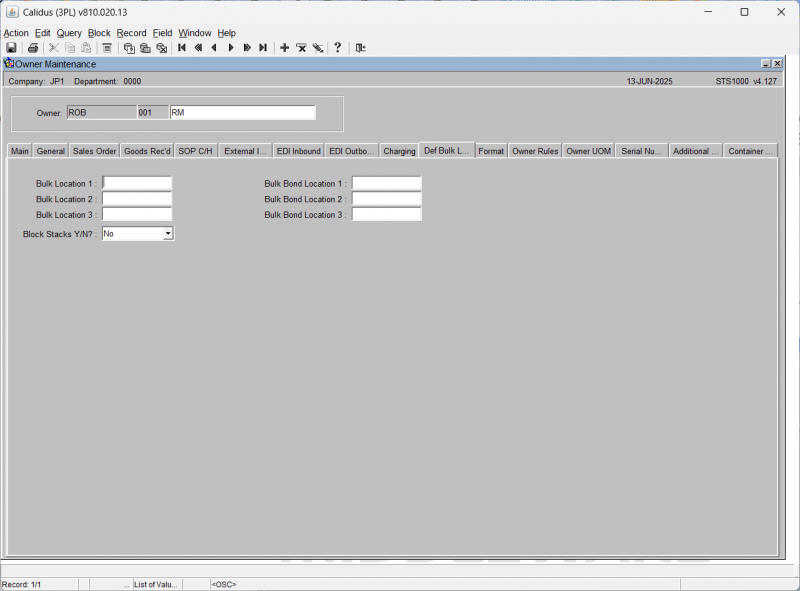
| Field Name | Description | Options | Generic Value |
|---|---|---|---|
| Bulk Location 1 | Defines the first anchor point for putaway | Must have been created in location codes maintenance or left blank - LOV available | Defined by the client |
| Bulk Location 2 | Defines the 2nd anchor point for putaway | Must have been created in location codes maintenance or left blank - LOV available | Defined by the client |
| Bulk Location 3 | Defines the last anchor point for putaway | Must have been created in location codes maintenance or left blank - LOV available | Defined by the client |
| Bulk Bond Location 1 | Defines the first anchor point for putaway for a bonded warehouse | Must have been created in location codes maintenance or left blank - LOV available | Defined by the client |
| Bulk Bond Location 2 | Defines the 2nd anchor point for putaway for a bonded warehouse | Must have been created in location codes maintenance or left blank - LOV available | Defined by the client |
| Bulk Bond Location 3 | Defines the last anchor point for putaway for a bonded warehouse | Must have been created in location codes maintenance or left blank - LOV available | Defined by the client |
| Block Stacks Y/N | Can the owner use block stacks? Note, if this flag is set to 'N', the owner will not be able to use pallet exchange or move pallets from any use type 'M' location | Y or N | Defined by the client |
Owner Maintenance - Format Tab
This screen will determine which client specific formats will be used for printing documents and labels. Note, each format used must be a valid source format i.e. WHR1700_CSP exists as a program, but WHR1700_XXX does not.

| Field Name | Description | Options | Generic Value |
|---|---|---|---|
| PRINT FORMATS | |||
| GRN Checklist | The format to be used for the GRN checklist (produced at receipt) | FWL, CLD (blank will denote the FWL generic) | Blank |
| Goods Receipt Note | The format to be used for the GRN note (produced at receipt) | FWL,(blank will denote the FWL generic) | Blank |
| Pick List | The format to be used for the pick list | FWL, CSP, SCH (blank will denote the FWL generic) | Blank |
| Pick By | Determines the sequence the allocated order lines will appear on the pick list | Sort by Aisle Sort by Location Sort by Stockist Sort by product type Sort by Rotation System Default |
System Default |
| Movement Pick List | The format to be used for the movement list (produced at stock or pallet move) | FWL, (blank will denote the FWL generic) | Blank |
| Despatch | The format to be used for the GRN note (produced at receipt) | FWL, SCH (blank will denote the FWL generic) | Blank |
| Collection Note | The format to be used for the collection note (produced at receipt) | FWL,(blank will denote the FWL generic) | Blank |
| External Despatch | |||
| LABEL FORMATS | |||
| Rotation Labels | Rotation label format - produced at receipt | FWL, (blank will denote the FWL generic) | Blank |
| Pallet Label - PLBC | Pallet label format - produced at receipt | FWL, SCH (blank will denote the FWL generic) | Blank |
| Sup Code on Pall Label? | Should the supplier code appear on the receipt label | Y or N - will default to Y | Y |
| Product Label - PROL | Stock level receipt label format - produced at receipt | FWL, (blank will denote the FWL generic) | Blank |
| Case label - RECL | Case level label format - produced at receipt | FWL, (blank will denote the FWL generic) | Blank |
| Picking Label | Picking label format | FWL, SCH, PIP, RYA (blank will denote the FWL generic) | Blank |
| Picking Label Control | Determines when and how pick labels should be produced | A - Do not prompt, use defined N - Pick labels not required Y - Prompt for label format |
Defined by the client |
| Shipping Label Despatch Label | Shipping label format OBS, PIP (client specific, STR | None | Defined by the client |
| Shipping Label control | Determines when and how ship labels should be produced | A - Do not prompt, use defined N - Ship labels not required Y - Prompt for label format |
N |
| Transport Label | Transport label format - produced at pick | Y - Yes, produce simplified labels for the stock owner C - Refer to customer level setting N - No simplified labels required |
Blank |
| Default Comm Inv Type | Option select
AAA Format NKT Format XXX Format |
||
| Ticket Label at PL | Do not produce ticket or label
Produce ticket but not label Produce ticket and pallet label Prompt user whether to print |
||
| Shipping Labels at PL | Yes or No | ||
| Print Dnote When ** | Default
Create Desp Note at Allocation Print document at Pick Print document at Packing Print document at Despatch At Alloc/Pick when fully alloc Print at either Pick or Desp |
Default | |
| Waybill Format | |||
| Pallet Label | |||
| Other | |||
| Despatch | |||
| Short Receipt | |||
| GRN Type | Manifest
Purchase Order Non-Purchase Order Return of Non Sales Order Return of Sales Order |
||
| Alloc Email Format | |||
| Stock Re-order Email Format | |||
| Receipt | |||
| Sales Order | |||
| Short Pick Email Format | |||
| Short Pick Email Address | |||
| Stock Take Formats | |||
| Stock Take Format | |||
Owner Maintenance - Owner Rules Tab
This screen allows you to assign rules to a specific owner. Note, the rules themselves must have already been created in warehouse rules control maintenance for type 'OWNR'

| Field Name | Description | Options | Generic Value |
|---|---|---|---|
| Rule ** | The rule code to be applied to this owner | Must have been created in warehouse rules control | Defined by the client |
| Description | The description for the rule - note, this will default from the description set up in warehouse rules control | Non | N/A |
| Flag ** | The flag used to determine whether this rule is to be used, and how it is to be used (if applicable) | Determined by the flag size and valid values set in warehouse rules control | Defined by the client |
Owner Maintenance - Owner UOM Tab
This screen will determine for this owner, which units of measure are allowed and their conversion factors. The values set in here will then be used in other screens, i.e. stock maintenance to assign valid units of measure
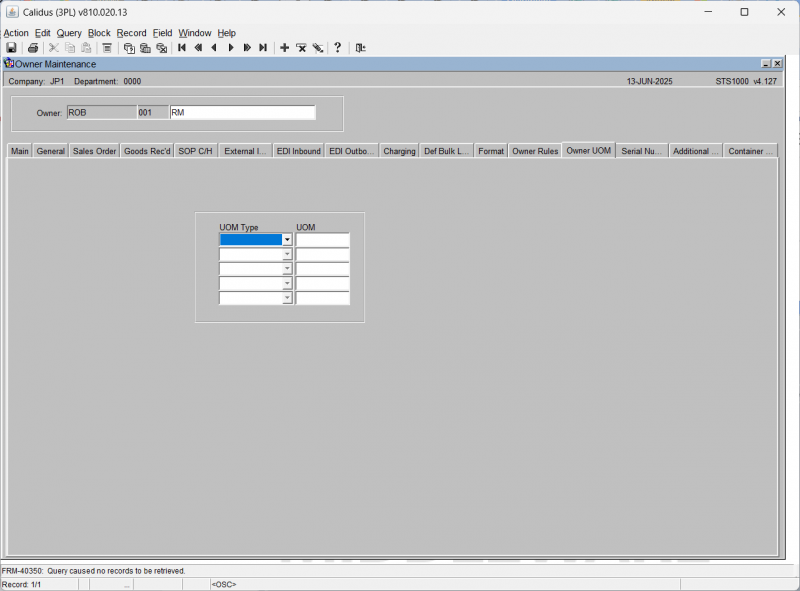
| Field Name | Description | Options | Generic Value |
|---|---|---|---|
| UOM Type ** | The type of unit of measure to be created | A - Area L - Length V - Volume W - Weight |
Defined by the client |
| UOM ** | The default unit of measure for this type | Must have been created in general codes, type 'UOM' | Defined by the client |
Owner Maintenance - Serial Number Tab
Only enter if serial numbering is required for the owner.
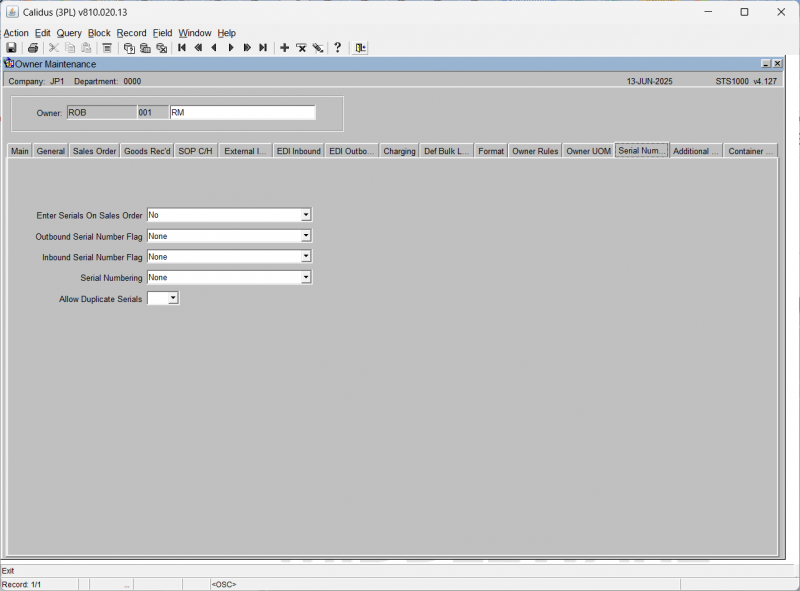
Values
Enter Serials on Sales Order
| No | (0) | Serial numbers not required at order entry |
| Optional allow held serials | (1) | Entry of serial numbers at order entry is optional (Free and held serial numbers can be entered) |
| Mandatory allow held serials | (2) | Entry of serial numbers at order entry is mandatory (Free and held serial numbers can be entered ) |
| Optional allow free serials | (3) | Entry of serial numbers at order entry is optional (Only free serial numbers can be entered) |
| Mandatory allow free serials | (4) | Entry of serial numbers at order entry is mandatory (Only free serial numbers can be entered) |
Ordering of held stock is currently done by using a line type R. For Medical Number functionality all ordering - both for free and held stock - will now be done through line type M functionality
Outbound Serial Number Flag
| None | (0) |
| Capture at Pick | (1) |
| Capture Latest at Pack | (2) |
| Capture Latest at Despatch | (3) |
| Capture Latest at POD | (4) |
Inbound Serial Number Flag
| Not required | Serial numbers are not required at Goods Receipt |
| Optional at Pre advice | This option should be used if serial numbers are to be entered at either pre advice or receipt confirm stage. |
| Mandatory at Pre advice | This option will be used if serial numbers are mandatory at the pre advice stage, and only displayed in the goods receipt confirmation screen. |
Serial Numbering
| None | Serial numbering is not required for this Owner / Stock code. |
| Case | Serial numbering is required for this stock code. 1 serial number is expected for every case. |
| Unit | Serial numbering is required for this stock code. 1 serial number is expected for every unit |
Allow Duplicate Serials
| No | Not allowed for this Owner/Stock Code. |
| Yes | allowed for this Owner/Stock Code. |
Owner Maintenance - Additional Control Tab
| Field Name | Description | Options | Generic Value |
|---|---|---|---|
| Organisation Name | |||
| Sub Building Name | |||
| Building Name | |||
| PO Box Number | |||
| Building Number | |||
| Thoroughfare Descriptor | |||
| Double Dependent Locality | |||
| Dependent Locality | |||
| Post Town | |||
| County | |||
| Postcode | |||
| Delivery Country | |||
| Phone Number | |||
| Contact | |||
| Consumable Owner | LOV available | ||
| Packing Group | |||
| Auto Pack Calculation Reqd | Yes or No | ||
| Carriers | |||
| Carrier | LOV Available | ||
Owner Maintenance - Container Yard Tab
| Field Name | Description | Options | Generic Value |
|---|---|---|---|
| Enabled | Yes or No | No | |
| Service | |||
| Carrier |
Owner Ware Parameters
This screen is almost identical to the system parameters screen, with the exception of a few fields. Where possible the screen should be setup exactly as per system parameters.
Owner Ware Parameters - Main Tab
![]() Note: For certain functionality such as barcode pallet labels this screen must be maintained.
Note: For certain functionality such as barcode pallet labels this screen must be maintained.
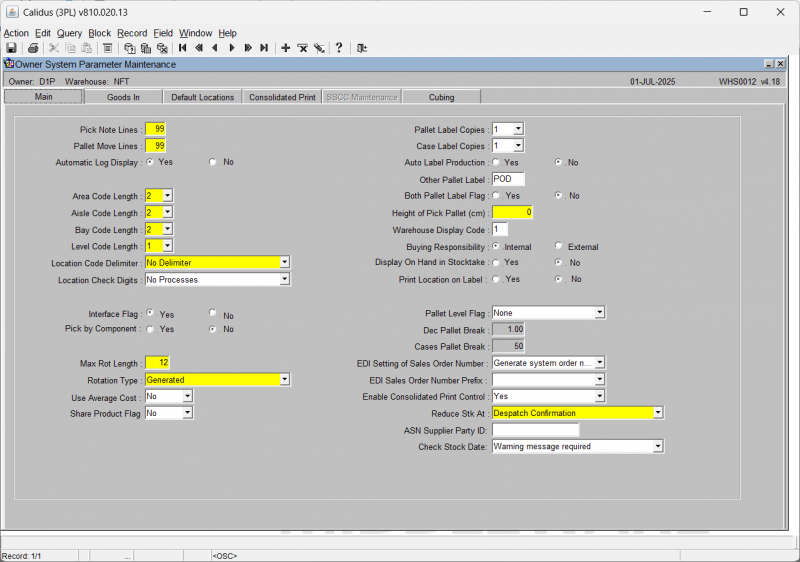
| Field Name | Description | Options | Generic Value |
|---|---|---|---|
| Pick Note Lines ** | The maximum number of lines printed on a pick note | 0-99 | 99 |
| Pal Move Lines ** | The maximum number of lines on a pallet move ticket print | 0-99 | 99 |
| Auto Log Display ** | Check box to determine whether you wish to see the allocation log | Check box, Yes or No | Y |
| Area Code Length ** | Number of characters the area code will be | 0-4 | Defined by the client |
| Aisle Code Length ** | Number of characters the aisle code will be | 0-4 | Defined by the client |
| Bay Code Length ** | Number of characters the bay code will be | 0-4 | Defined by the client |
| Level Code Length ** | Number of characters the level code will be | 0-4 | Defined by the client |
| Location Code Delimiter | States which delimiter will be used within the location code i.e. A1-001-01 | 1 - No Delimiter 2 - Space 3 - Forward Slash / 4 - Colon : 5 - Back Slash \ 6 - Underscore _ 7 - Minus - |
3 |
| Location Check Digits | Allows the user to state whether they will use check digits and which processes will use them | Y - All Processes N - No Processes * - Stock Movements and GRN |
N |
| Interface Flag ** | Used for RDT to determines whether RF functionality will be used | Check box Y or N - default is N | N |
| Pick by Component ** | Determines whether a product can be picked as a component (kits) | Check box Y or N - default is N | N |
| Max Rot Length ** | Maximum length of the system rotation number | 0-14 | 11 |
| Rotation Type ** | Determines whether system rotation numbers will be used and how they will be used | S - Sell by date O - Generated with manual override G - Generated M - Manual Entry B - Back Date/Seq R - Rotation |
G |
| Use Average Cost | Y or N | N | |
| Share Product Flag | Y or N | N | |
| Pallet Label Copies ** | Sets the number of auto-generated labels to be produced | 01-Apr | 1 |
| Case Label Copies | Sets the number of auto-generated case labels to be produced | 01-Apr | 1 |
| Auto Label Production ** | Defines whether labels are produced without user intervention | Y or N | Y |
| Other Pallet Label | The ability to enter an additional label format if required | Must be a valid format or left blank | Blank |
| Both Pallet Label Flag ** | Determines whether a pallet and case label should be produced automatically | Check box Y or N - will default to N | N |
| Height of Pick Pallet (cm) | Used for pallet levelling - determines the height of the pick pallet (not migrated) | 0 - 99999 | 0 |
| Height of Pick Pallet ** | The specific height of the pallets to be stored in pick locations | 0-9999 | 20 |
| Warehouse Display Code | Enables the autogeneration of ware_last_numbers (not migrated) | 0-Z or leave blank | 1 |
| Buying Responsibility ** | Used in purchase order suggestion to dictate the source of receipts | Internal check box or external check box | External |
| Display On Hand in Stocktake ** | Determines whether on hand can be displayed on stock take count sheets | Yes or No | Yes |
| Print Location on Label ** | Specifies whether the location code will be printed on the receipt label | Yes or No | Yes |
| Pallet Level Flag ** | Dictates at which point pallet levelling will be carried out | N - None P - Pallet Fill Factor C - By No. of Cases |
None |
| Dec Pallet Break | Decimal value | ||
| Cases Pallet Break | Integer value | ||
| EDI Setting of Sales Order Number | Use Extra Reference
Use Sellers Order Reference Use Customer PO Reference Generate System Order Number |
Generate System Order Number | |
| EDI Sales Order Number Prefix | Prefix with Owner Code
No Order Prefix |
||
| Enable Consolidated Print Control | Yes or No | ||
| Reduce Stk At ** | At which WH process will the stock levels be reduced? | Pick Confirmation
Despatch Confirmation |
|
| ASN Supplier Party ID | |||
| Check Stock Date | Warning Message Required
Error Message Required No check required at pick conf |
Owner Ware Parameters - Goods In Tab
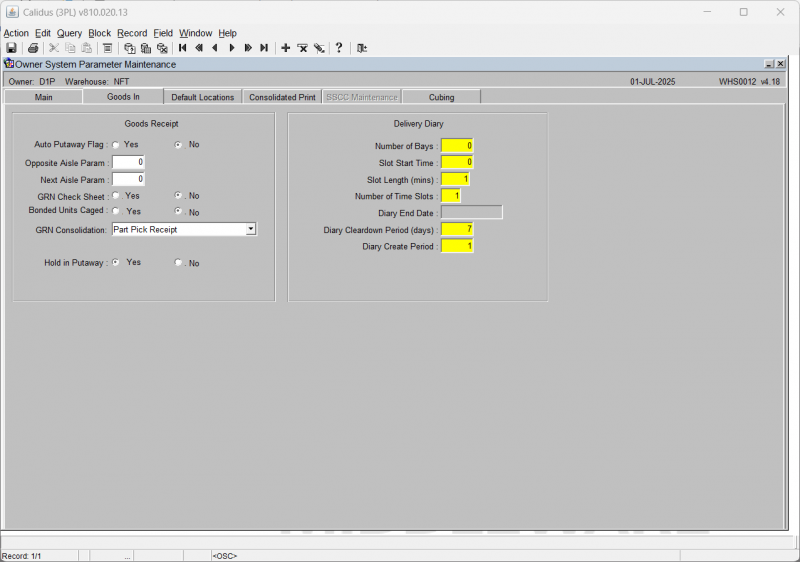
| Field Name | Description | Options | Generic Value |
|---|---|---|---|
| Auto Putaway Flag ** | Determines whether the warehouse will be utilising autoputaway. i.e. the system will suggest the locations to receive into | Y or N | Defined by the client |
| Opposite Aisle Param | Sets the number of locations the autoputaway will go through before moving to the opposite aisle | 0-4999 - will default to 0 | 999 |
| Next Aisle Param | Sets the number of locations the autoputaway will go through before moving to the next aisle | 0-4999 - will default to 0 | 999 |
| GRN Check Sheet ** | Is a GRN Check sheet required at pre advice? | Y or N | N |
| Bonded Units Caged ** | Will the warehouse be brining in non-duty paid stock stored in cages? | Y or N | N |
| GRN Consolidation | Specifies whether you wish to generate replenishments at receipt | N - None B - Pick Replen. & Partial Bulk P - Pick Replen. during GRN Part Pick Receipt |
N |
| Hold In Putaway ** | Determines whether you wish stock to be automatically put on hold until putaway confirmation has been completed | Check box - Y or N | Y |
| Number of Bays | Transport field - not used - specifies no. of bays to be loaded into | 0-9999 | 0 |
| Slot Start Time | Transport field - not used - defines when the receiving starts | 00:00 - 23:59 | 00:00 |
| Slot Length (mins) | Transport field - not used - defines how long a truck can be at the bay | 1-600 | 1 |
| Number of Time Slots | Transport field - not used - defines how many slots can be used in one day | Jan-99 | 1 |
| Diary Cleardown Period (days) | Transport field - not used - defines how many days before the diary is cleared down | Jan-99 | 1 |
| Diary Create Period | Transport field - not used - defines the number of days to be generated by the diary | 1-999 | 1 |
Owner Ware Parameters - Default Locations Tab

| Field Name | Description | Options | Generic Value |
|---|---|---|---|
| ID Station | Receipt ID Station | Predefined in locations maintenance | Blank |
| Reject Spur at ID Station | Client Specific -spur locations | Predefined in locations maintenance | Blank |
| Q/A | Default quarantine location | Predefined in locations maintenance | Blank |
| Turntable | Default turntable locations | Predefined in locations maintenance | Blank |
| Input Spur to Conveyor | Client specific - spur locations | Predefined in locations maintenance | Blank |
| Default Marshalling Location ** | Required to enable picking and allocation to function | Predefined in locations maintenance | Defined by client |
| Default Despatch Bay Location | Default Outbound Bay Location | Predefined in locations maintenance | Blank |
| Pre Advice Virtual Location | Default receiving staging area | Predefined in locations maintenance | Blank |
| Quarantine in Marshal | Default additional quarantine stage within the outbound process | Predefined in locations maintenance | Blank |
| Auto bulk Reject | Client Specific - Default rejection location | Predefined in locations maintenance | Blank |
| Default Ship Pallet Build Locn | Used in Shipment Pallet Building as default staging area | Predefined in locations maintenance | Blank |
| Default Damages | Default damages location for putaway | Predefined in locations maintenance | Blank |
| Default Cons Good Ret | Predefined in locations maintenance | Blank | |
| Default Cons Bad Ret | Predefined in locations maintenance | Blank | |
| Bonded Putaway Locations | 3 x Warehouse level anchor point for autoputaway for bonded warehouses | Predefined in locations maintenance | Blank |
| Unbonded Putaway Locations | 3 x Warehouse level anchor point for autoputaway for duty paid warehouses | Predefined in locations maintenance | Blank |
Owner Ware Parameters - Consolidated Pallet Tab
| Field Name | Description | Options | Generic Value |
|---|---|---|---|
| Owner Code | The Owner Code and Name | Display only | |
| Pick List | An option of whether the Pick List is consolidated, plus the default printer name. | Yes or No | |
| Out of Stock | An option of whether the Out of Stock is consolidated, plus the default printer name. | ||
| Replenishment | An option of whether the Replen List is consolidated, plus the default printer name. | ||
| Despatch Note | An option of whether the Despatch Note is consolidated, plus the default printer name. | ||
| Shipping Label | An option of whether the Shipping Label is consolidated, plus the default printer name. |
Owner Ware Parameters - Cubing Tab
This tab covers the options available for cubing of pallets during the picking process.
| Field Name | Description | Options | Generic Value |
|---|---|---|---|
| Cubing Required | Whether the owner uses the Cubing functionality. | Option select Yes or No | No |
| Replens Lower Priority | Whether to lower the priority of any replens when executing them through the WCS | Option select Yes or No | Yes |
| Allow SKUs on Split Pallets | Whether order lines/SKUs can be split across multiple picking pallets, or whether the full line quantity must stay on one picking pallet. | Option select Yes or No | Yes |
| Build Height (cm) | The target build height. | Decimal | As required. |
| Max Build Height (cm) | The maximum build height | Decimal | As required. |
| Min Build Height (cm) | The Minimum build height | Decimal | As required. |
| Final Sortation of Page | How the tasks and/or pick list will be sorted for picking. | By Strength
By Location As Built |
By Strength |
Owner Prompt Maintenance
This screen is used to enable the logon id to have a default owner. If the default owner flag is set to ‘No’ the user will always be prompted for an owner and will never have the common owner defaulted.
Owner Prompt Maintenance
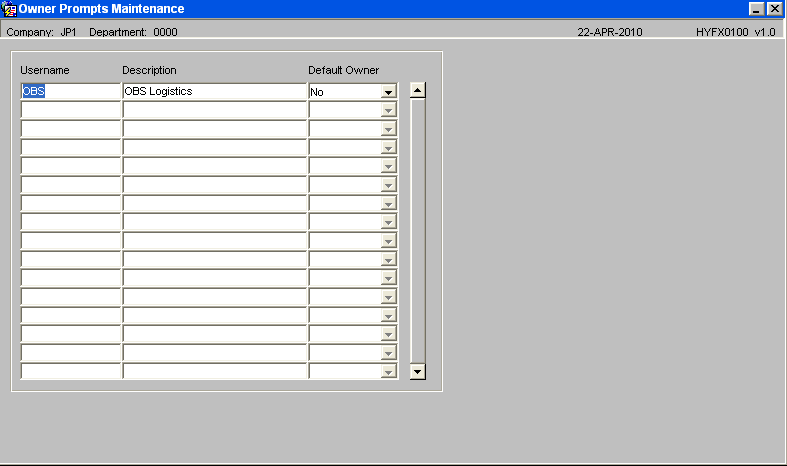
| Field Name | Description | Options | Generic Value |
| Username | The logon id onto the wms system | Defaulted in from users maintenance – no entry allowed | Defined by the client |
| Description | The name assigned to the logon id | Defaulted in from users maintenance – no entry allowed | Defined by the client |
| Default Owner | Determines whether this logon id should have its owner defaulted throughout the wms | Y or N – default is N | Defined by the client |
Owner Copy
The form will enable the user to create a new owner by copying an existing owner and all of its requisite data settings and parameters.
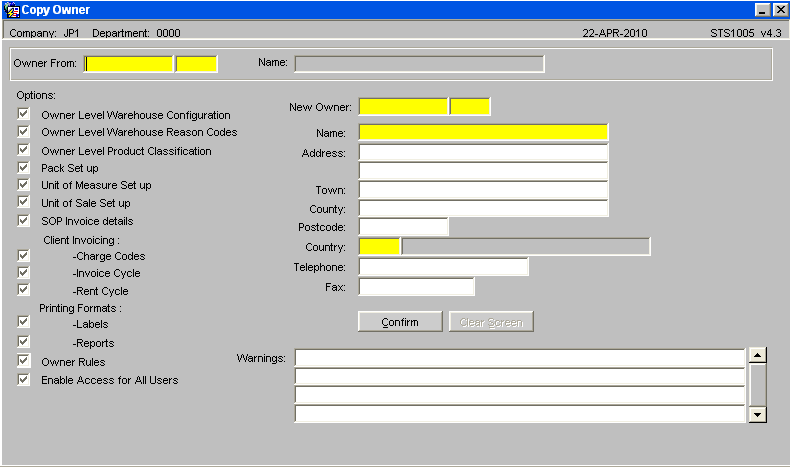
| Field Name | Description | Options | Generic Value |
|---|---|---|---|
| Owner From | Owner code of an existing client whose configuration you wish to copy | Look up on Owner table | Defined by User |
| Sub code | Sub code of the existing owner | Enter standard code | 001 |
| Name | Name of the owner | As held against the owner code | System value |
| Options | A list of options that can be selected or omitted during the copy routine | ||
| Owner Level Warehouse Configuration | Will copy Owner System Parameters - WHS0012 | Y or N | Y |
| Owner Level Warehouse Reason Codes | Not yet migrated | Y or N | Y |
| Owner Level Product Classification | Will copy Product Class Maintenance - STKPRCO01A | Y or N | Y |
| Pack Set up | Will Copy Pack Parameter Maintenance - WHS1944 | Y or N | Y |
| Unit of Measure Set Up | Will copy UOM Maintenance - SOS1300 | Y or N | Y |
| Unit of Sale Set up | Will copy Sales Units from Owner Maintenance/Unit of Sale tab - STS1000 | Y or N | Y |
| SOP Invoice Details | Will copy Sales Order Invoicing details | Y or N | Y |
| Client Invoicing - Charge Codes | Will copy the owner associated charge codes - WHS7100 | Y or N | Y |
| Client Invoicing - Invoice Cycle | Will copy the invoice cycle parameters - Owner Maintenance/Charging | Y or N | Y |
| Client Invoicing - Rent Cycle | will copy the rent cycle parameters - Owner Maintenance/Charging | Y or N | Y |
| Printing Formats - Labels | Will copy label formats i.e. Receipt Pallet Labels | Y or N | Y |
| Printing Formats - Reports | Will copy report formats i.e. Pick List and Despatch formats | Y or N | Y |
| Owner Rules | Will copy the Owner Rules table and it settings | Y or N | Y |
| Enable Access for All users | The ower code will be inserted into the profile of all users on the Database - FXMUSER/Owners | Y or N | Y |
| New Owner Details | |||
| New Owner ** | The new owner code followed by the sub code | 10 Character field - Alpha/Numeric | Defined by user |
| Name ** | The name of the new owner | 30 Character field - Alpha/Numeric | Defined by user |
| Address | Address details | Optional | Defined by user |
| Town | Town | Optional | Defined by user |
| County | County | Optional | Defined by user |
| Postcode | Postcode | Optional | Defined by user |
| Country ** | County | Look up on Countries Table | Defined by user |
| Telephone | Telephone | Optional | Defined by user |
| Fax | Fax | Optional | Defined by user |
| Warnings | Any options or parameters that cannot be copied from the original template will generate a warning/information message. Please note that the owner will still be created but the issues shown will need to be addressed. | ||
| Buttons | |||
| Confirm | Button that will create the new owner code with the selected options | ||
| Clear Screen | Button that will clear the form ready for the creation of the next record | ||
Appendix A: Document History
A.1 References
| Ref No | Document Title & ID | Version | Date |
|---|---|---|---|
| 1 | UG 352167 C-WMS Standing Data Set-up Guide | v2.0 | 13/11/2018 |
| 2 | |||
| 3 |
A.2 Glossary
| Term or Acronym | Meaning |
|---|---|
| Ad Hoc (WCS) | A task instigated on the device (spec. Ad Hoc Pallet Move), rather than a task instigated from the WMS and Stock Control. |
| Advice Note Number | An external reference linked to a Goods Receipt. |
| Aisle (WMS) | A component of a location; usually a space through rows of racking or storage locations; a collection of locations; |
| Allocation (order) | The systemic act of identifying and ring-fencing product matching the order requirements, following proscribed warehouse rules. |
| Anchor Point (WMS) | A starting location for a search for a suitable storage location; auto-putaway location suggestion start point. |
| Area (WMS) | A collection of aisles; an area in the warehouse for a particular purpose. |
| Batch (WMS) | A production batch of a product; a quantity of product that is considered to have the same characteristics; |
| Bay (Warehouse) | A physical loading or unloading point for the warehouse. |
| Bay (WMS) | A component of a location; usually a space between uprights in racking, comprising several levels (horizontal beams). |
| Bay Diary | The mechanism for booking hauliers inbound/outbound and assigning bays. The OBS Logistics system is CALIDUS Bay Diary. |
| Block Stack | A stable stack of pallets. |
| Booking | A time slot for a bay, booked with a Carrier/Haulier. |
| Bulk (WMS) | Bulk storage; Usually full-pallet storage areas, racked or stacked. |
| Cancellation (WCS) | The facility to cancel a task due to some problem, identified by the user when performing the task. |
| Carrier; Haulier | The transport company (by road or sea). |
| Check Digit (WMS) | A short code, usually randomly generated and stored against a location, used to help identify that a user is at the right location before they proceed with a warehouse task. |
| Container | The actual physical container, identified uniquely by the Container Number. The Container will be identified as a Container Type. |
| Container Type | Descriptive of the use and capability and physical characteristics of a container. Container types are 40ft End Loader, Reefer, etc. |
| Container Yard | The storage areas for full and empty locations in the facility. The OBS Logistics system to manage this area is CALIDUS Container Yard. |
| CSV | Character-separated values; a text file with multiple rows and values, usually separated with commas. |
| C-WCS | CALIDUS WCS, the name of the OBS Logistics Warehouse Control system |
| C-WMS | CALIDUS WMS, the name of the OBS Logistics Warehouse Management system |
| Dead Leg (WCS) | A movement of a truck without a pallet; wasted resource. |
| Despatch | The final physical stage of an order; handover of goods to the haulier. |
| De-stuffing | The act of emptying a container and storing the contents in the warehouse. |
| Drive-In | A drive-in location, typically multi-level, multi-deep location. |
| Dry Van | Any type of non-refrigerated container. |
| Dual Cycling | Processes utilizing P&D locations for interleaving tasks in and out of specific areas, reducing dead leg movements. |
| EDI | Electronic Data Interchange; any form of automatically or semi-automatically uploading or downloading information from a computer system without manually re-keying the information. |
| ERP | Enterprise Resource Planning; a system for this. |
| Exchange (WCS) | Specifically Pick Exchange or Task Exchange. The process of allowing a user to select a different pallet in a multi-pallet location and exchanging the expected pallet for this one. If the pallet is planned for another task, task exchange will complete this task instead of the expected one first. If the pallet is not planned, pallet exchange will swap the pallet (if suitable). |
| GR; GRN | Goods Receipt; Goods Receipt Number or Note |
| High Bay | Typically tall (greater than 5 level) racking, usually full pallet storage, usually Narrow Aisle. |
| Inbound (Booking) | A booking linked to a Goods Receipt. |
| JIT | Just In Time; processes designed to trigger at the last instant. |
| KPI | Key Performance Indicator. |
| Level (WMS) | A component of a location; usually the vertical compartments of an area, delineated by horizontal beams. |
| Loading | The act of loading pallets onto a vehicle. |
| Location (WMS) | A uniquely identified space in the warehouse for storage of product. There are many types, most commonly Floor locations (for example, Marshalling, Inbound), Racking or Bulk Storage Locations and Pick faces. |
| Manifest | The contents of a vehicle or container. |
| Marshalling | The act of bringing pallets for an order or load together; an area to do so. |
| Multi-deep | A location with 2 or more pallets stored sequentially i.e. only one can be accessed at a time. |
| NA (WCS) | Narrow Aisle; usually any area in the warehouse that is restricted access due to space limitations, Narrow Aisles have associate P&D locations. |
| Outbound (Booking) | A booking linked to a Sales Order. |
| P&D | Pick-up and Drop-off locations; locations used to control the handover of pallets between distinct areas, for example between chambers and the wider area of the warehouse. |
| PI; Perpetual Inventory | The act of continuously checking locations in a warehouse, identifying and correcting product quantity issues. Usually used in Bulk environments rather than Pick Faces. In pick faces, this process is called is called Residual Stock Balance and usually takes place after picking from a pick face. |
| Pick Face | A location designed for picking part of a pallet of stock. Usually a low- or ground-level location. |
| Pick List (order) | The instructions to pick pallets or cases from locations; the paper report associated to this; the stage of preparing these instructions; the sending of these instructions to WCS. |
| PO | Purchase Order. |
| Pre-advice; Goods Receipt Pre-advice | An advanced notification of what is being received. Part of a manifest. Pre-advices can be stock and quantity, or individual pallet level. |
| Putaway | The physical move of a pallet to a storage location as a result of receiving it into the warehouse. |
| RAG | Acronym for Red/Amber/Green, a traffic light colouration system depicting (in sequence) Errors, Warnings or Informational messages. Usually used in operational monitoring to effectively display when certain processes are not working as expected. |
| RDT | Radio Data Terminal. |
| Reefers | Refrigerated Containers. |
| Replen; Replenishment | The act of moving product (usually a pallet) from bulk storage to a pick face. |
| Reposition (WCS) | The facility to change the location of a movement or putaway when at the final destination, sue to some issue discovered when performing the task. |
| RF | Radio Frequency; An RF device is an RDT, typically used by CALIDUS WCS for executing warehouse tasks. |
| SCR; CR | Software Change Request. |
| Short Allocate | The process of not fulfilling an order due to failure to identify sufficient product at Allocation. |
| Short Pick | The process of not fulfilling an order due to failure to identify sufficient product when picking. May also be used as a term to indicate Short Allocation. |
| SO | Sales Order. |
| Truck Types | Plants, Mechanical Handling Equipment. For example, Reach trucks, Counter-balance trucks, pallet riders, etc. |
| UOM | Unit of Measure. |
| WA (WCS) | Wide Area; usually any area in the warehouse that is not restricted access due to space limitations, for example, floor areas, not Narrow Aisle. |
| WCS | Warehouse Control System |
| WMS | Warehouse Management System |
Oracle App Terms
| Term or Acronym | Description |
|---|---|
| DDL | Drop-down list of values, usually denoted by a down-arrow to the right of the field. |
| LOV; Lookup | List of Values. A Lookup of values from data maintained in the system (rather than fixed data that a DDL may be used for), |
| Form; Window; Screen | Alternative terms for each displayed window within the application. |
| Tab | A tab on a form, which contains its own panel of data to be viewed or entered. Denoted in this guide as italics. |
| Panel | A panel on a form contains data to be viewed or entered. |
| Button | A clickable button. Denoted in this guide as bold. |
| Field | Data that can be displayed or entered is referred to as a field. This is the core of where you will view or enter information within Forms. Fields are described by Labels and usually come as a pair. These (and labels) are denoted in this guide as italics. |
| Table | When there are multiple data to be shown in a group, those records are usually displayed in a table. Tables allow showing multiple fields in columns, are scrollable vertically and sometimes horizontally, will have buttons for title labels if the columns are sortable and may allow configuration, usually through a Configure button, which will take you to WHS0909. |
| Label | A label is the annotation of the field being displayed and typically tells you what it is. CWMS supports multi-lingual labels in a lot of forms. |
| Click; Select | Clicking the left mouse mutton on a field, table or button using your mouse. |
| Right-click | Clicking the right mouse mutton on a field, table or button using your mouse. |
| Viewport | The viewport is the means by which you are viewing the forms within the application. Within a browser, this may be the size of the browser window, or just a fixed portion. When running the app browserless, this is the size of the window displayed on your desktop. |
| DPI | Dots per Inch. This may be used to adjust the resolution of the application within the viewport. |
| Menu | The menu where all forms are selected, as opposed to the Oracle standard query menu. In CWMS, this is the Explorer window. (FXMEXPLR). Menu items are sometimes denoted in this guide in bold/italics. Slashes typically indicate a sub-menu. for example, Warehousing/Goods Receipt/Goods Received Advice denotes the top-level Warehousing menu, then the Goods Receipt sub-menu, and then the Goods Received Advice screen. As menus in CWMS are pretty much completely user configurable, this may have less meaning than you would like in your system, and we generally refer to these on what we call the standard menu structure. |
| Control Bar; Format bar | The control bar for searching, inserting and pretty much doing anything within the selected Oracle form. See System_Navigation_Guide#Format_Toolbar for more information. |
| Key; Function Key; Shortcut Key | Alternative terms for a keypress on your keyboard. In this guide, these are denoted with fixed width text in a box e.g. F4
|
| Multi-Modal | A term denoting whether the forms can be open and active at the same time. CWMS is not multi-modal. |
| Scroll | The act of moving a fixed window vertically or horizontally to show more information. Typically you will see and use these on tables. |
| Check box | A simple notation of whether something is enabled or disabled (or Yes or No, True or False, etc) is typically displayed as a checkbox. If the box is checked, then this means Yes/True/Enabled, the functionality depending on the label of the checkbox. |
| Option Select; Radio Buttons | When a field has a limited number of options, sometimes this is displayed with bulleted options, all visible n the screen. This is called an Option Select or Radio button. The option that is selected will have the button filled in. |
A.3 Document History
| Version | Date | Status | Reason | By |
|---|---|---|---|---|
| 1.0 | 08/03/2011 | Issue | Initial Version | LBW |
| 2.0 | 13/11/2018 | Issue | Updated version for formatting | ANW |
| 2.01 | 1/7/2025 | Draft | Updated to latest version | ANW |
A.4 Authorised By
Matt Tipping | Aptean Project Manager | _____________________________ |
Tony Walker | Aptean Consultant | _____________________________ |
